Anacharis (Elodea Densa) Pond Plant - Care & Grow Guide
Pond Academy is reader-supported. Buying through links on our site may earn us an affiliate commission. As an Amazon Associate I earn from qualifying purchases.

Anacharis is a well-known fast-growing submerged oxygenating pond plant. They help keep pond water clean and clear, where they compete with algae for nutrients.
Anacharis have a broad appearance spectrum – sometimes they are bright green, other times they are dark, seaweed-like green. Whichever color you find them in, they maintain a leaf size of 0.5-1.5 inches, with their stems all attached to just one root base.
Anacharis goes by many different names including leafy elodea, dense waterweed, common waterweed, Brazilian waterweed, Egeria, or Brazilian elodea. These numerous names are attributed to its diverse origins – Anacharis are found in different parts of the world.
They were first discovered in South America. However, they are now common in native areas in Argentina, Uruguay, and Brazil. Anacharis can be found on all the continents, except Antarctica.
Common Names
Leafy elodea, dense waterweed, common waterweed, Brazilian waterweed, Egeria, or Brazilian elodea
Plant Type
Submerged/Floating
Light Requirements
Full Sun to Partial Shade
Hardiness Zones
USDA 5-11
Bloom
Summer - Typically June to August
Grow Up To
10 ft spread (3m)
Water Depth
Minimum 10 inches and up to 15ft (4.5m)
How To Plant Anacharis In A Pond
Growing Anacharis in a pond is fairly easy. Simply attach weights to the bunch of plants before submerging them in the pond. The weights ensure the plants sink to the bottom of the pond, from where they grow upwards to the surface.
Another way of planting is to detach the bottom 1 inch of leaves from the plant before tucking it into the bottom sediment. It is best to anchor the plants in 1-2 inches of substrate, so they don’t float back to the surface.
Or simply drop them in your pond and let them float!
Anacharis supports different planting media. It will survive in anything at the base of the pond – aquarium gravel, muck, loam, or even aquatic soil.
For best results, ensure a minimum spacing of 1 inch among Anacharis plants. This will prevent any direct nutrient competition among them.
Get Our Best Pond Tips Sent to Your Inbox for Free!
Join thousands of others and learn from our decades of pond building and maintenance experience! Your pond will thank you!
By subscribing you agree to receive emails from PondAcademy.com. We will always respect your privacy and you can unsubscribe at any time.
Anacharis Care Guide
The first thing to watch out for is the potential dominance of the Anacharis plants in your pond or aquarium. You can prevent this by pruning the plants or pulling them entirely. The latter is advisable in cases where theres no animal life, such as pond fish, to regulate the growth.
Similar to most fast-growing aquatic plants, overwintering the Anacharis plants can be a lot of (if not too much) work. But if your pond is susceptible to freezing beyond surface ice formation, it is better to trim multiple stems at least 8 inches in length. You can either leave these clippings submerged in an aquarium or tub with minimal light (2 watts per gallon in the case of aquariums) or keep them indoors floating.
Anacharis Care Card
Download our free printable care card for the Anacharis plant! Click the care card below and save the PDF file to your computer. You can easily print off the 3x5 care card or access it right from your phone. Get all the important information you need to keep your Anacharis plants healthy and happy!
Plus, we provide a blank card for you to print and fill out yourself. Print it as many times as you like to create cards for all your plants!

Pond Plant Care Card Set







